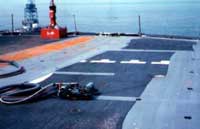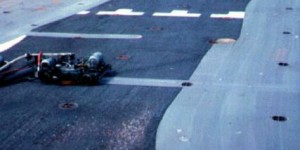USS GEORGE WASHINGTON
 On Sept. 25 USS GEORGE WASHINGTON’S (CVN 73) Project in concert with five local Navy commands took a major step in advancing the state-of the- art technology for conducting Aircraft Carrier Maintenance. The commands include Supervisor of Shipbuilding (SUPSHIP), Portsmouth; Commander Naval Air Force, Atlantic; Regional Support Group, Norfolk; and the GW.
On Sept. 25 USS GEORGE WASHINGTON’S (CVN 73) Project in concert with five local Navy commands took a major step in advancing the state-of the- art technology for conducting Aircraft Carrier Maintenance. The commands include Supervisor of Shipbuilding (SUPSHIP), Portsmouth; Commander Naval Air Force, Atlantic; Regional Support Group, Norfolk; and the GW.
One of the most difficult and time consuming evolutions that a CVN must complete during an availability is the resurfacing of its flight deck. The GW is no exception. Before GW can leave NNSY, it must complete certification of its flight deck, including inspection of its flight deck surface.
In an effort to minimize impact of this work, a new technology is being employed for the removal of the non-skid. Instead of using the conventional and intrusive bead blasting method, a hydroblast removal process is being used. This method has taken extensive research to iron out the technical issues. This research included an on-site demonstration of the technology by the hydroblast machine manufacturer. Once the engineering and environmental issues were resolved, the other organizations involved were brought into the process. The results of the research were then turned into a set of instructions that could be incorporated and executed by the project team. In keeping with the project team’s spirit of integrated maintenance this evolution was advanced from a science project into a working plan, able to be fully integrated with the availability schedule.
The ability to complete the resurfacing evolution using the hydroblast method is important to NNSY. This type of process is a major step in the direction of the “Clean Availability” and represents cutting edge technology in naval ship maintenance. NNSY is completing a major upgrade to all four catapults, and using the hydroblast resurfacing method allows the catapult work, which must be done using strict cleanliness controls to be completed simultaneously. It also allows the resurfacing to be completed during a fair weather time of year, which is a major factor in first time quality.
 In order to get a successful product, a coordinated effort is required. This effort is being maintained by a team of professionals from the flight deck community,” said Jim Shoemaker, Project Superintendent. The team consists of: Chief Warrant Officer Stacey Schlosser of CVN-73; Senior Chief Aviation Boatswain’s Mate H (Aircraft Handling) Bill Gibson, Commander Naval Air Forces, Atlantic; Bo Weaver, SUPSHIP, Portsmouth; Brian Stump, Surface Technology and Richard Dupuy, Ultra High Pressure (UHP Projects Incorporated).
In order to get a successful product, a coordinated effort is required. This effort is being maintained by a team of professionals from the flight deck community,” said Jim Shoemaker, Project Superintendent. The team consists of: Chief Warrant Officer Stacey Schlosser of CVN-73; Senior Chief Aviation Boatswain’s Mate H (Aircraft Handling) Bill Gibson, Commander Naval Air Forces, Atlantic; Bo Weaver, SUPSHIP, Portsmouth; Brian Stump, Surface Technology and Richard Dupuy, Ultra High Pressure (UHP Projects Incorporated).
The GW/NNSY project team has always been interested in advancing new technology. The ability to prove this new maintenance method which has profound impact on ship’s ability to meet its mission, was no exception. If you would like to see the future of CVN maintenance, stop by Drydock 8,” said Shoemaker.
Reprinted from the October 2, 1998 SERVICE TO THE FLEET newspaper. Copies available upon request.




Follow Us!